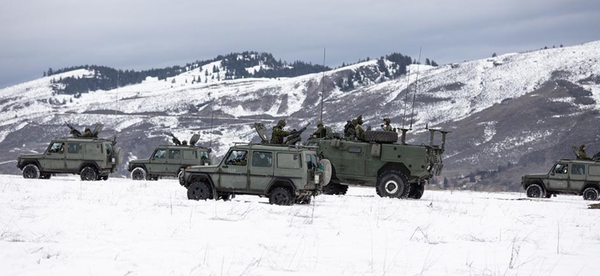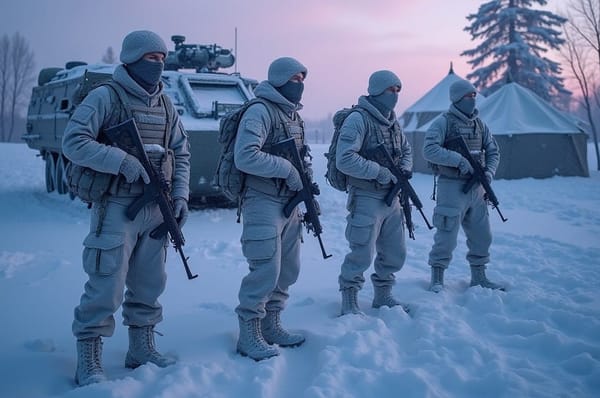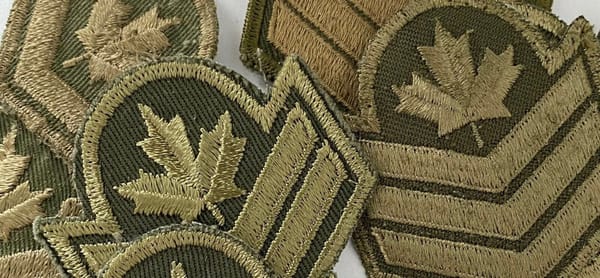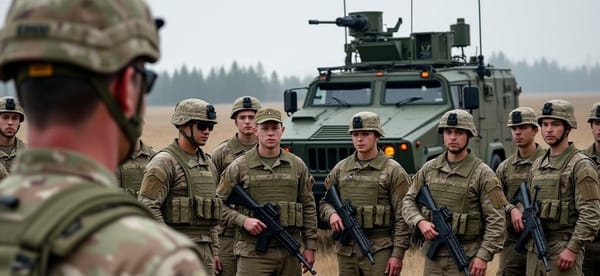Military Procurement: Canada Needs a Separate Department of Materiel and Military Manufacturing

Canada’s military procurement apparatus has a primary mission: get kit to the warfighter. Instead, we’ve built a system that delivers excuses, delays, political insulation, and vote-pandering wrapped in a ribbon of 'industrial regional benefits' (IRBs). Procurement is split across a dozen offices, filtered through a Byzantine bureaucracy, and shackled by a procurement culture that values process over performance.
This isn’t a resourcing problem. It’s a structure problem.
Here’s how Canada finally begins to address the problem:
Re-Establish the Department of Defence Production (1951 - 1969)
Background: A Longstanding Problem
Canada’s procurement failures aren’t new. The Department of Defence Production once managed military acquisition centrally, but was dissolved in 1969 (surprise, surprise, that era seems to be the root of every problem). Since then, procurement has been fractured, politicized, and painfully slow.
As early as the 1980s, headlines flagged systemic dysfunction. From the CF-18 delays to the ongoing F-35 saga, the symptoms have been consistent: cost overruns, capability gaps, and glacial timelines.
A 2016 article in Policy Options noted that defence procurement required consensus from “four or more ministers and their departments,” driving up costs while delivering less capability. The 2024 Hill Times described the system as “ongoing dysfunction,” citing the acquisition of two Navy supply ships that overshot budget by nearly $1 billion. As you may recall, getting those supply ships functional required the ritualistic political sacrifice of an Admiral's career. Admiral Mark Norman later sued (and won) the crown for millions.
And this is while Canada's current Liberal government prepares to increase its defence spending by 27% over the next five years as part of NATO commitments (allegedly, these promises have been made many times before). On top of that, the new Canada-EU defence pact will require interoperable kit and flexible procurement — something our current system cannot deliver.
Worse still, not only does Canada have a problem with the glacial pace of procurement, it consistently replaces old equipment with much smaller numbers of the "new" (typically no longer new by the time it's actually delivered) equipment. All three branches of the military have repeatedly suffered this phenomenon:
Army: Shrinking in the Cold
The Army acquired 114 Leopard-1 tanks in 1977, a model that West Germany introduced and began delivering 10 years earlier. In 2007, Canada retired the Leopard-1 and replaced it with 100 Leopard-2 variants, a model that was originally introduced only two years after Canada acquired its original Leopard-1's. Now about 82 Leopard-2's remain, but a maximum of FIFTEEN are operational. Post WW2, the Army had roughly 168,000 vehicles in its inventory. Cumulative production saw over 800,000 military vehicles produced in Canada. This equated to roughly one vehicle for every three soldiers, making the Canadian Army one of the most mechanized armies in the world. As of 2025, the Army operates a fleet of approximately 5000 vehicles, the vast majority are 40 years old and dilapidated. And as for personnel? At its maximum strength, the Army had 500,000 personnel in uniform. Now? 20,000 regulars (only 3,000 of that being actual infantry). And Canada has a far larger economy and population than it did during those peak years immediately post WW2.
Navy: From Carriers to Canoes
The Navy's case is particularly egregious. From 1948 to 1989, the Royal Canadian Navy operated an impressive array of warships. Three "light" aircraft carriers, four full destroyers, 20 destroyer-escorts, five submarines, 20 minesweepers, 15 patrol vessels, three supply ships, and a myriad of auxiliaries (fireships, tugs, etc.). A disturbing number of these ships were sailed for forty years and decommissioned without replacements in the early 1990s. Now, the RCN is comprised of a woeful 12 frigates (35 years old), four submarines (35 years old, can't be all fielded at once, persistent maintenance issues since acquisition), five 'Arctic and Offshore Patrol Ships' (barely armed, with less firepower than a modern battle tank), 12 "Coastal Defence Vessels" (35 years old and again woefully under-armed sporting only two machine guns and nothing else). Canada has launched a process to acquire 12 conventional attack submarines, nobody is holding their breath. And the "River-Class Destroyer" program (classed as frigates to everyone but the RCN, strangely) will ostensibly acquire 15 new frigates but is already maddeningly over budget and late. At one point, the RCN had nearly 100,000 personnel in uniform. In 2025? Around 8500 on a good day.
Air Force: Everything that Used to Fly
At its Cold War peak of the 1980s, the RCAF simultaneously operated three front-line fighter types: 239 CF-104 Starfighters (two variants), 132 CF-101 Voodoos, and 133 CF-5 Freedom Fighters. These aircraft filled interceptor, strike, and tactical roles across Canada and Europe. Under the Pierre Trudeau government's "new fighter aircraft program", all of these aircraft were replaced with just 120 CF-18 Hornets, of which soon to be replaced by just 88 F-35s. From 500 operational combat aircraft to 80 - that is a steep drop in capability, redundancy, and reach. The helicopter fleet suffered no less. Ignoring the questionable reasoning of having everything that flies belong to the Air Force, the RCAF currently operates 17 CH-149 Cormorants (SAR, 25 years old), 17 Sikorsky Cyclones (Anti-Submarine, 10 years old), 100 CH-118 Griffons (questionable numbers operational, 31 years old), and 15 Chinooks (heavy transport, 15 years old). The Cormorants replaced 50+ year old Sea Kings, went massively overtime and over budget and are of questionable quality. The Cyclones were delayed multiple times are again of questionable quality. The Griffons are effectively a civilian helicopter painted green and replaced four separate other models that were all superior to the Griffon itself. The Chinooks were originally sold by one government only to be reacquired in lesser numbers. Despite all this, the RCAF has never operated a single attack helicopter, never acquired the globally standard Blackhawk, and continues to stretch its aging fleet to the breaking point.
So what's the fix? As usual, look to the recent past.
Re-establish the Department of Defence Production
The Government of Canada had this right, once. From 1867 to the Second World War, there were many iterations of departments and organizations tasked with defence production and procurement. This effort culminated in the Department of Defence Production (DDP), active from 1951 to 1969. Headed by the Minister of Defence Production, the DDP was solely responsible for all military procurement and manufacturing in Canada.
The DDP procured all goods and services required by the Department of National Defence (DND) and the Canadian Armed Forces (CAF). It also had a mandate to ensure Canada maintained the production capacity and materials necessary to support domestic materiel manufacturing. Crucially, it oversaw the design, development, and production of weapons systems and defence equipment within Canada. It was also responsible for seven crown corporations critical to the defence industry.
Of course, nothing good can last. The Glassco Commission of 1963 recommended rolling all government procurement into one centralized department. That recommendation should have been ignored. Instead, a separate agency should have been created for civilian procurement. But that didn’t happen—and the DDP died a slow bureaucratic death, eventually morphing into today’s 'Public Services and Procurement Canada' (PSPC).
Let PSPC handle civilian procurement and contracting.
The re-established DDP will:
- Own 100% of CAF procurement, from boots to warships.
- Sever all ties to PSPC and other civilian procurement entities.
- Absorb existing authorities such as ADM(Mat), DGLEPM, and others.
- Embed experienced CAF personnel, prioritizing ex-military hires.
- Organize into Army, Navy, and Air Force sectors.
- Receive an annual budget from the Treasury Board, with top-ups for major acquisitions or rearmament.
- Operate under the strategic direction of CAF and DND—or under direct orders from the Governor General in crisis conditions.
- In wartime, the Governor General may authorize DDP to bypass standard federal procurement rules. That’s how you build speed into the system when it counts.
Crown Corporations under the DDP
The DDP previously oversaw several crown corporations, including but not limited to:
- Polymer Corporation – Established during WWII to produce synthetic rubber for military use. A success by any measure, its Sarnia, ON facilities were so iconic they appeared on the 1971 $10 bill.
- Research Enterprises Limited – Produced radar systems, optics, and electronics. It was the largest employer in the Toronto neighbourhood of Leaside and produced over $3 billion (2025 adjusted) in high-tech defence equipment.
- Turbo Research/Orenda and Victory Aircraft – These companies began as crown corporations, later spun off into successful private ventures. The crown seeded an industry where none existed, then stepped back to let the market take over. It’s a model that hasn’t been used in decades, but one we should revisit.
There’s no reason we can’t repeat these successes. For example, the DDP could acquire a failed or underutilized auto plant (such as GM’s Oshawa facility) and retool it to produce rugged, militarized trucks. Once proven reliable and viable, a civilian variant could be produced and sold to offset costs—or even generate profit, especially given the high price and low reliability of modern pickup trucks.
This approach would:
- Provide stable employment in economically vulnerable areas.
- Establish a sovereign source of standardized military vehicles.
- Reduce reliance on foreign suppliers.
- Create a replicable model for other defence production ventures.
- Offer a pipeline for veteran employment, especially from technical branches like RCEME.
The DDP worked. It can again.



